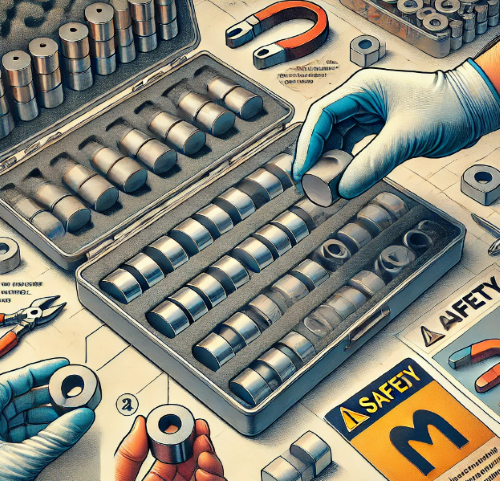
Introduction
Neodymium magnets, known for their remarkable strength and versatility, are widely used in various industries, from electronics to automotive applications. However, these powerful magnets are also susceptible to corrosion, chipping, and demagnetization. Understanding how to protect them effectively is crucial for maintaining their performance and longevity. This article will discuss strategies for avoiding corrosion, preventing chipping, protecting against demagnetization, and ensuring safe handling.

How to Avoid Neodymium Magnet Corrosion
Neodymium magnets are particularly prone to corrosion due to their iron content. When exposed to moisture or harsh environments, they can quickly degrade, losing their magnetic properties. To avoid corrosion, consider the following strategies:
1. Coating: Applying a protective coating is one of the most effective ways to prevent corrosion. Common coatings include nickel, epoxy, and zinc. Nickel plating is particularly popular due to its excellent resistance to corrosion while maintaining a smooth surface. Epoxy coatings provide an additional layer of protection, especially in humid conditions.
2. Storage Conditions: Store magnets in a dry environment. Using silica gel packs or desiccants in storage containers can help absorb moisture. Avoid exposing magnets to extreme temperatures or humidity, as these conditions can accelerate corrosion.
3. Surface Treatments: Consider surface treatments like phosphorization or electrophoresis. Phosphorization creates a protective layer that enhances adhesion for additional coatings and improves corrosion resistance. Electrophoresis offers excellent adhesion to the magnet surface and resistance to salt spray and acidic environments.
How to Protect Neodymium Magnets from Chipping
While neodymium magnets are hard, they are also brittle, making them susceptible to chipping when dropped or subjected to impact. To minimize the risk of chipping, follow these guidelines:
1. Use Coated Magnets: Opt for neodymium magnets that come with a protective coating, such as a nickel-copper-nickel layer. This coating not only protects against corrosion but also adds a degree of impact resistance.
2. Handle with Care: Always handle magnets carefully. When moving or positioning them, ensure you are aware of their surroundings to avoid accidental collisions with hard surfaces or other magnets.
3. Custom Protective Covers: For larger or more fragile magnets, consider creating custom protective covers made from soft materials that can absorb shocks. This will provide an additional layer of protection against impacts.
4. Storage Solutions: Store magnets in dedicated containers or padded cases to prevent them from colliding with one another. Avoid stacking magnets haphazardly, as this can lead to chipping.
How to Protect Your Magnets from Demagnetization
Demagnetization occurs when a magnet is exposed to high temperatures, strong magnetic fields, or physical trauma. Here are some strategies to protect your neodymium magnets from demagnetization:
1. Temperature Control: Neodymium magnets can lose their magnetic properties if exposed to temperatures above their maximum operating limits (typically around 80–100°C or 176–212°F). Ensure that your magnets are kept within their specified temperature range.
2. Avoid Strong Magnetic Fields: Keep neodymium magnets away from other strong magnets or magnetic fields. When storing, ensure that they are not in close proximity to devices that generate strong magnetic fields, such as transformers or motors.
3. Minimize Physical Shock: Prevent dropping or knocking magnets against hard surfaces. Use padding or cushioning when transporting magnets to absorb shocks and minimize the risk of demagnetization.
Neodymium Magnets: Safety and Cautions
While neodymium magnets offer numerous benefits, they also come with safety considerations. Here are some important precautions to take:
1. Handling Safety: Neodymium magnets are incredibly strong and can snap together with significant force, potentially causing injury. Always handle them with care, using gloves if necessary to avoid pinching fingers.
2. Storage Safety: When not in use, store magnets in a safe place out of reach of children and pets. Use magnetic shields or containers to prevent accidental attraction and collisions.
3. Eye Protection: When working with larger neodymium magnets, wear safety goggles to protect your eyes from potential flying debris if a magnet breaks or chips.
4. Read Safety Manuals: If you purchase neodymium magnets, always refer to the safety manuals provided. These documents will offer valuable information on handling, storage, and potential hazards.
Conclusion
Protecting neodymium magnets from corrosion, chipping, and demagnetization is essential for maintaining their performance and extending their lifespan. By employing protective coatings, careful handling, and proper storage techniques, you can ensure that your neodymium magnets continue to operate effectively. Always prioritize safety when working with these powerful magnets, and consult professional resources for additional guidance.
With the right precautions, you can enjoy the many benefits that neodymium magnets offer across various applications. For more information, please check Stanford Magnets.
